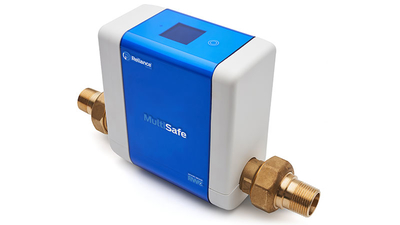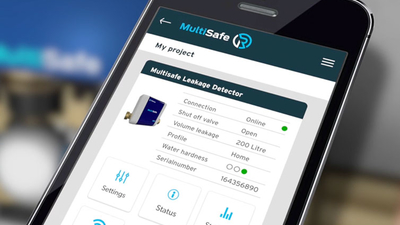When, why, and how to use MultiSafe Leak Detection Technology

Whether it’s a new build, retrofit or a commercial project, it’s becoming increasingly important to detect leaks as soon as they happen. When left unnoticed, the financial costs of leaks can quickly add up. If you’re working on a construction site, then they can cause long delays and penalties, not to mention possible damages.
Plus, there’s the environmental impacts to consider, with the potential water loss from a burst pipe reaching as a high as 3000 litres per hour.
As an installer, you might start to see more and more projects looking to avoid these issues by making use of leak detection technology. So, in this blog we cover all you need to know about the Reliance Valves MultiSafe Leak Detector, including what it is and when, why, and how to use it.
What is the MultiSafe Leak Detector?
The award-winning MultiSafe Leak Detection System from Reliance Valves is WRAS approved and can identify water loss in real-time. When it does, the property owner is sent a text or an email notifying them of the leak, and the isolation valve is automatically closed so that no water is supplied to the affected area.
For particularly high-risk areas, such as utility or IT rooms in commercial buildings, the MultiSafe Leak Detection system can be used alongside the MultiSafe Floor Leak Sensor. This sensor monitors floors for wet areas and sends alerts when water is detected.
When to use leak detection technology
It’s a common misconception that leaks only happen in older properties, when they are an issue in all types of buildings from domestic to commercial and new to old. In fact, 43% of UK homes experience a water leak, with 75% of these occurring in flats and apartments.
RWC’s MultiSafe Leak Detector is suitable for many property types including domestic homes, apartment complexes, commercial and public buildings, high-rise flats, tall buildings, and large-scale developments.
It is particularly useful for owners of second homes or holiday lets, as well as frequent travellers, all of whom might not be able to detect leaks for quite some time. In this case, the MultiSafe Leak Detector can save owners from potential “surprises” upon return to their properties by allowing them to act quickly when needed – even from afar.
When working on a new build property, leaks are most likely to occur within the first 18 months of being completed and occupied. So, utilising leak detection technology can be key to avoiding unnecessary damage.

Why you should use the MultiSafe Leak Detector
When you consider that something as simple as a dripping tap can result in 1 litre of water lost per hour, it’s important that any leaks are detected quickly. But, in 99% of buildings, finding them is a manual and time-consuming process. Plus, with many low leaks often occurring in plumbed-in elements or in pipework that is hidden, these can be nearly impossible to detect early.
As an installer, making use of the MultiSafe Leak Detector can help you save time and prevent any delays that could happen as a result of leaks.
How to use the MultiSafe Leak Detection Technology
Once it’s been set up, the Reliance Valves MultiSafe Leak Detector Control Valve sets the expected water use for the property. It then uses this to monitor the water usage against what is expected so it can identify any potential failures before they lead to costly leaks.
In high-rise flats, and other similar properties, multiple devices can be connected on the same Wi-Fi, which means the system can be centrally controlled.
When the system notices any unusual activity that might be caused by a leak, it will send an alert to the property owner and then automatically shut off the water supply.

How to install the MultiSafe Leak Detector:
You should install leak protection from the commissioning phase and as a safety device between the first and second fix. This is because leaks often occur when the mains have been commissioned and the buildings have been stage-filled with water.
To make installers lives easier, the MultiSafe Leak Detector has been designed with MBSP union connections. Here’s the three steps to take when installing it:
- The Reliance Valves MultiSafe Leak Detector should be installed on the main cold-water line before it branches to any appliances, and after any other control valves.
- To install it you need to cut the pipework and mount the MultiSafe Control Valve using union connections and then insert the battery pack and plug the mains adaptor into a 230v electrical supply (within 2 meters).
- Then connect it to the Wi-Fi and download the free app
When you’re installing it, make sure you pre-test and test all the components to ensure they meet the required regulations. After installation, but before the building is signed off and the systems are commissioned, you’ll need to complete pressure testing.
